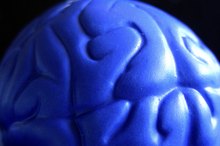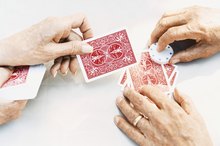Activities for Low Functioning People With Autism
Low-functioning people with autism often engage in self-stimulating behaviors such as rocking back and forth in their seats, flicking fingers in front of their eyes or putting objects in their mouths. Sensory activities provide the stimulation that their nervous systems seem to be seeking. At the same time, fine-motor motor activities that are fun and motivational provide alternatives to maladaptive behaviors.
Vestibular Movement Activities
Movement and exercise not only keep our hearts healthy and muscles toned, but they stimulate the vestibular sensory system. The vestibular sense organs are located inside the inner ear and they enable us to respond to the pull of gravity and balance to catch ourselves when thrown off center. We receive strong vestibular stimulation when spinning on merry-go-rounds, jumping on trampolines, swinging and sledding down hills. Individuals with low-functioning autism who grew up in institutional settings may not have received adequate amounts of this stimulation while growing up. They may also have a brain disorder that makes it difficult to organize sensory information. A daily “sensory diet” designed by an occupational therapist might help these individuals receive the movement stimulation they need 1.
- Movement and exercise not only keep our hearts healthy and muscles toned, but they stimulate the vestibular sensory system.
- The vestibular sense organs are located inside the inner ear and they enable us to respond to the pull of gravity and balance to catch ourselves when thrown off center.
Heavy Pressure Touch Activities
Activities for Adults With Developmental Disabilities
Learn More
Another important sensory experience low-functioning autistic people might seek out is called “deep pressure tactile." These individuals often find light touch, such as a tap on the shoulder, threatening and crave the deep pressure touch experienced during a wrestling match, pillow fight or bear hug. Provide deep pressure by sandwiching the person between two large cushions and pressing down, such as in the game “hot dog” in which children pretend to be the dog between two rolls as the parent pushes down. Deep pressure can also be provided by rolling a large ball up and down the person’s body. An occupational therapist may recommend wearing a weighted vest or collar for short periods of time during the day as the sensory input helps the person to relax 1.
- Another important sensory experience low-functioning autistic people might seek out is called “deep pressure tactile."
- These individuals often find light touch, such as a tap on the shoulder, threatening and crave the deep pressure touch experienced during a wrestling match, pillow fight or bear hug.
Fine-motor Activities
Adding a sensory component to fine-motor activities often motivates the person with autism to develop functional hand use. They may enjoy holding or manipulating objects that vibrate. The motor from an electric toothbrush can be placed inside a can that is used for placement tasks such as inserting a card through a slit in the can lid. Music switches that are activated when pressed can be placed inside a box. When enough bean bags are inserted, the switch will be activated and music plays. Activities that provide sensory stimulation and promote meaningful hand activities might decrease maladaptive behaviors that are harmful and interfere with learning.
- Adding a sensory component to fine-motor activities often motivates the person with autism to develop functional hand use.
- The motor from an electric toothbrush can be placed inside a can that is used for placement tasks such as inserting a card through a slit in the can lid.
Related Articles
References
- The Recycling Occupational Therapist
- Case-Smith J, Weaver LL, Fristad MA. A systematic review of sensory processing interventions for children with autism spectrum disorders. Autism. 2015;19(2):133-148. doi:10.1177/1362361313517762.
- Centers for Disease Control and Prevention. Autism Spectrum Disorder (ASD). Diagnostic Criteria. Updated August 27, 2019.
- Case-Smith J, Weaver LL, Fristad MA. A systematic review of sensory processing interventions for children with autism spectrum disorders. Autism. 2015;19(2):133‐148. doi:10.1177/1362361313517762
- Case-Smith J, Weaver LL, Fristad MA. A systematic review of sensory processing interventions for children with autism spectrum disorders. Autism. 2015;19(2):133-148. doi:10.1177/1362361313517762.
- Grapel JN, Cicchetti DV, Volkmar FR. Sensory features as diagnostic criteria for autism: sensory features in autism. Yale J Biol Med. 2015;88(1):69–71.
- John, L. Multi-sensory environments and their use by people with autism. Altogether Autism Journal. 2017. Issue 1.
Resources
Writer Bio
Barbara Smith is an occupational therapist who has more than 30 years of experience working with children and adults with disabilities. She is a public speaker and the author of "The Recycling Occupational Therapist," "Still Giving Kisses" and "From Rattles to Writing: A Parent's Guide to Hand Skills."








